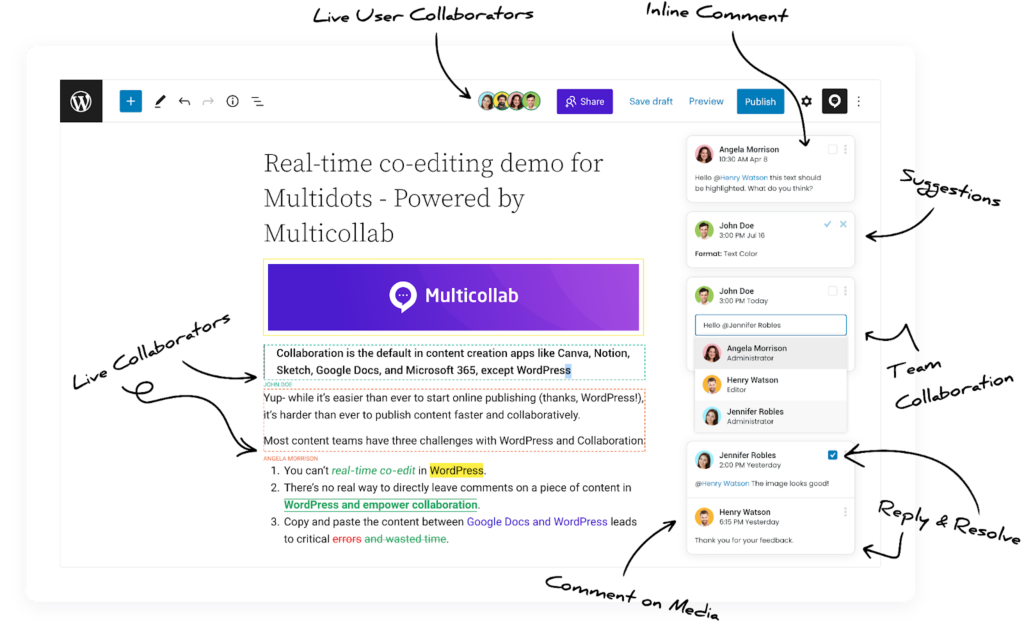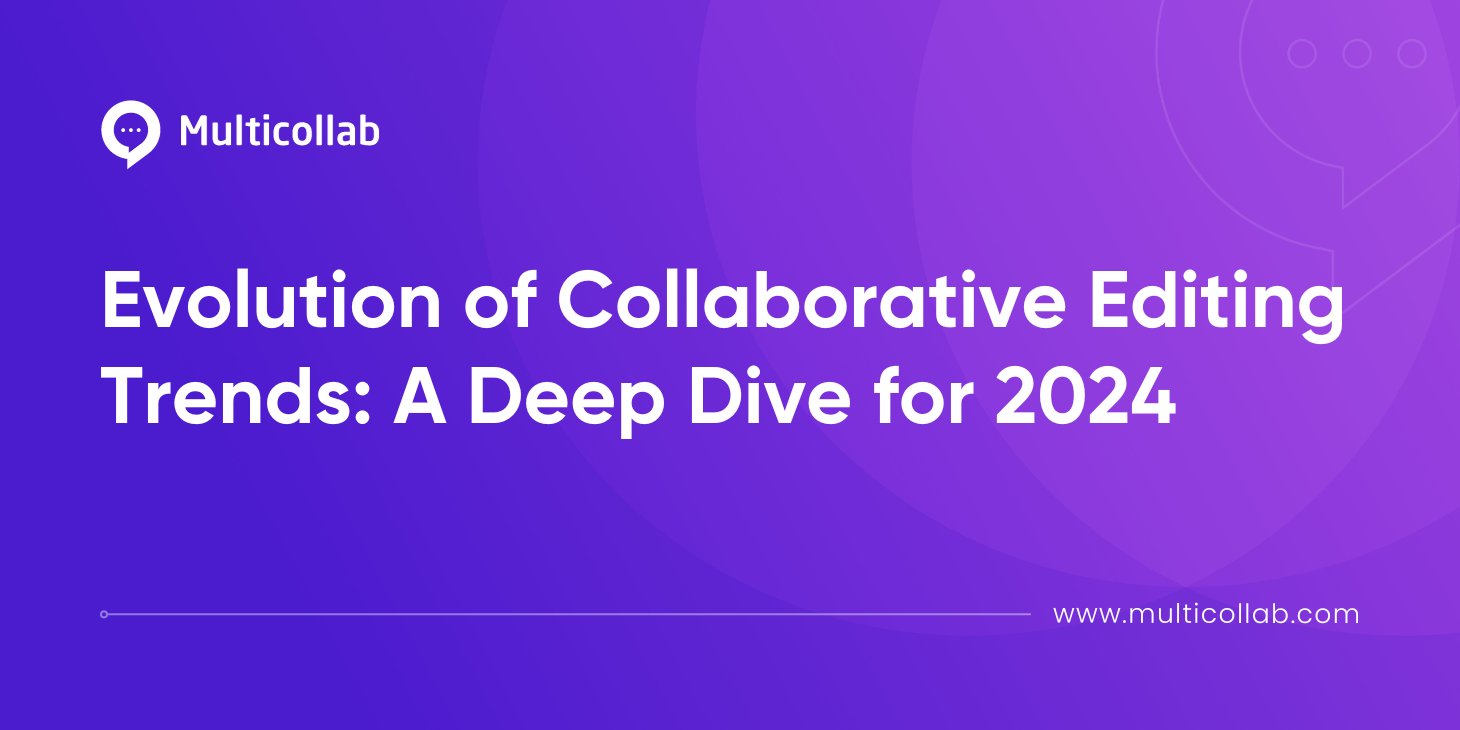Table of Contents
The process of crafting compelling and impactful content has undergone a significant transformation over the years. One of the key catalysts behind this evolution is the rise of collaborative editing tools. Traditionally, content creation was synonymous with individual authorship. Authors meticulously drafted their work, often relying on manual editing processes. However, as the demands for efficiency and collaboration increased, a shift occurred, leading to a new era where collaboration remains the key.
Rise of Collaborative Editing Tools
The landscape of content creation has been revolutionized by the rise of online collaboration platforms. As we step into 2024, dominant players like Google Docs and Microsoft 365, along with their AI supplements, will continue to reshape the collaborative editing scene.
These powerful tools continue to facilitate real-time editing, enabling multiple contributors to work seamlessly on a document simultaneously. Emphasizing the importance of version control, they ensure a smooth editing process with minimal conflicts. In an era where remote work has become the norm, the role of collaborative editing tools is pivotal in maintaining productivity and communication within virtual teams.
Collaborative editing has not only streamlined the content creation process but has also elevated the quality of the end product. The ability to edit in real-time fosters enhanced collaboration among team members. Diverse perspectives and ideas can be seamlessly integrated, resulting in a richer and more comprehensive output. The efficiency of workflows has improved, with content creators able to iterate rapidly.
Technology Trends Shaping Collaborative Editing
The integration of artificial intelligence (AI) in editing processes is a notable trend in 2024. AI-driven suggestions, automated proofreading, and the exploration of augmented reality (AR) and virtual reality (VR) contribute to the scenario of collaborative editing. Here’s an overview of collaborative editing trends over the years:
Early Collaborative Tools (1990s): In the early days, collaborative editing primarily relied on email exchanges and manual merging of documents. Basic version control systems like CVS (Concurrent Versions System) and Subversion were introduced, allowing teams to manage and collaborate on source code.
Rise of Wiki Platforms (2000s): The early 2000s saw the rise of wiki platforms like Wikipedia, which allowed multiple users to edit and contribute to content collaboratively. These platforms introduced the concept of real-time, web-based collaboration on documents, making it easier for users to work together without needing extensive technical expertise.
Cloud-Based Collaboration (2010s): The advent of cloud computing and online collaboration tools revolutionized how teams work together. Google Docs, introduced in 2006, allowed real-time collaborative editing of documents over the internet. Other platforms like Microsoft Office Online, Dropbox Paper, and Quip also emerged, offering similar functionality with different features and integrations.
Version Control Systems (2010s): Distributed version control systems like Git gained popularity, particularly in software development. Git enables multiple developers to work on the same codebase simultaneously and manage changes efficiently. Platforms like GitHub and Bitbucket further enhanced collaboration by providing hosting for Git repositories, facilitating collaboration on open-source projects.
Integrated Collaboration Suites (2020s): Integrated collaboration suites, such as Microsoft 365 and Google Workspace, became commonplace. These suites offer a comprehensive set of tools for document editing, communication, and project management. Video conferencing tools like Zoom and Microsoft Teams became integral to remote collaboration, providing real-time communication for teams spread across different locations.
Advanced Features and AI (2020s): AI-driven features, such as smart suggestions and predictive typing, have been integrated into collaborative editing tools to enhance productivity and efficiency. Real-time commenting, chat features, and task assignment within documents became standard, allowing teams to communicate seamlessly while working on shared projects.
Hybrid Work and Mobile Collaboration (ongoing): With the rise of hybrid work models, collaboration tools are increasingly emphasizing mobile compatibility and flexibility. Integration with project management tools, task automation, and artificial intelligence continues to evolve, enhancing the overall collaborative editing experience.
In-Application Editing Tools with Real-time Collaboration Capabilities
The trajectory of collaborative editing is anticipated to keep evolving, driven by technological advancements, shifting work dynamics, and the persistent demand for effective teamwork across various domains. However, the sheer count of the number of remote work and productivity tools has led to an overload of applications. This creates the need for a tool where collaboration is even more seamless and efficient.
Multicollab, a WordPress plugin, has revolutionized the collaborative document editing process of teams across multiple domains. It enables Google Docs-style editorial commenting in the Gutenberg Editor allowing teams to collaborate on documents in real-time, directly within WordPress.

When it comes to collaborative editing in WordPress, Multicollab emerges as a groundbreaking plugin designed to redefine how content teams work together. It features Inline Commenting for targeted feedback, akin to Google Docs. Team Collaboration invites editorial users with easy communication and timely email notifications, Suggestion mode tracks progress, Guest Collaboration involves non-WordPress stakeholders, and Slack Integration ensures crucial notifications reach the right audience. Users can attach documents to their comments, receive workflow insights, and manage permissions for adding comments and suggestions.
Best Practices for Collaborative Editing
- Clear communication among team members is crucial for a cohesive work environment. Avoid jargon and be concise to ensure understanding.
- A structured workflow is vital for editorial projects, maintaining order from brainstorming to final approval. It streamlines tasks, reduces confusion, and prevents oversights.
- Using version control systems like Git or collaborative platforms with revision history ensures changes are logged, tracked, and easily referenced. Clearly labeling and dating versions prevent confusion about the latest iteration, crucial in fast-paced environments with rapid iterations.
- Offering specific, constructive feedback is crucial for enhancing content quality. Focus on actionable points that guide team members on necessary adjustments. Cultivating an environment where discussing revisions is comfortable fosters creativity and continuous improvement. Encourage questions, suggestions, and content discussions.
- Platforms like Google Workspace and Microsoft 365, and collaborative WordPress plugins such as Multicollab provide real-time editing capabilities. This enables team members to work simultaneously on documents, enhancing efficiency and reducing turnaround times.
- A clear style guide covering formatting, tone, and brand guidelines maintains consistency in content, strengthening brand identity and professionalism. Easy access and understanding by all team members are crucial. Regular training reinforces adherence to the established guidelines.
- Regular check-ins act as a pulse check, enabling strategy adaptation and ensuring alignment with the project’s direction. Video conferencing tools, even in remote teams, enhance connection and understanding, fostering clearer discussions and stronger team relationships.
Conclusion
As we reflect on the evolution of content creation and the pivotal role collaborative editing tools play in this journey, it is evident that embracing the future is key. The collaborative editing landscape is dynamic, offering boundless opportunities for innovation and efficiency. 2024 is the year to take our content creation pursuits to new heights by embracing the best of these tools.
So, if you are a WordPress content team already working with collaborative editing tools like Google Docs and would like to experience enhanced features, here’s a 14-day free trial of Multicollab for you!








